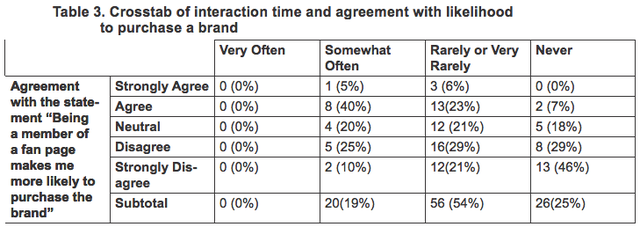From Elon Journal of Undergraduate Research in Communications VOL. 3 NO. 2Facebook Pages and Benefits to BrandsVI. DiscussionOn Facebook, there are many pages that have millions of likes, but it is unclear what exactly a like means for a brand. Previous research has looked at an individual's motivation for liking a Facebook fan page, but none has looked at the implications that the like button has for a brand. The purpose of this study is to determine what motivates individuals to like brand fan pages on Facebook and whether or not that individual becomes a member of a brand community by liking that page. Additionally, the study looked at how liking a Facebook fan page affected an individual's brand loyalty and purchase intentions. Overall, the study aimedat determining whether or not creating and maintaining a Facebook fan page is a beneficial tool for brands tocommunicate with their consumer base. The findings from the study do not provide a conclusive answer to RQ1. Data do not indicate a strong relationship between the amount of time an individual interacts with a fan page and the individual's brand loyalty. A crosstab of how often an individual interacts with a fan page and the respondent's agreement with the statement "Being a member of a fan page makes me more likely to purchase the brand" can be found in Table 3.
Overall, only 19% of study participants responded that they interact with fan pages somewhat often, as shown in Table 3. Of that 19%, only 45% agreed or strongly agreed with the statement, "I consider myself a brand loyal individual to brands I like on Facebook." This small percentage of people who interact with fan pages on a somewhat often basis consider themselves brand loyal does not support a relationship between the amount of time spent interacting with a page and brand loyalty. Among the participants, 54% responded that they rarely or very rarely interact with the fan pages that they like. Of that 54 percent, 29% agreed or strongly agreed with the statement, "I consider myself a brand loyal individual to brands I "like" on Facebook," while another 50% disagreed or strongly disagreed with the statement (the rest of respondents remained neutral). In contrast, 46% of study respondents who indicated that they never interact with the features of fan pages that they like strongly disagreed with the statement "I consider myself a brand loyal individual to brands I like on Facebook." This supports the research question that the amount of time an individual interacts with a fan page affects the individual's brand loyalty. Based upon the overall findings, it seems as though an individual's brand loyalty is not strongly affected by how often he or she interacts with the brand's Facebook fan page. Considering also low numbers in the cells on the top left corner, which should show a big number for a strong relationship between the amount of time an individual interacts with a fan page and brand loyalty, there is no strong evidence here to support RQ1 that there is a strong relationship between the two variables. Through RQ2, the study aimed to determine if an individual is expressing an affiliation with the brand by liking a page. This question is not supported by the findings. Over 50% of study participants disagreedor strongly disagreed with the statement "I feel connected to the fan pages that I like." Based upon these findings, it can be concluded that when an individual likes a Facebook fan page, they are not expressing a connection with the brand itself. It can be concluded that liking a Facebook fan page does not make that individual a part of a brand community. RQ3 explored the relationship between the amount of time an individual interacts with a fan page and the likelihood that he or she is to purchase a product or service being promoted by the page. Findings do not provide conclusive evidence to suggest that the amount of time an individual interacts with a fan page predicts that individual's likelihood to purchase the product or service promote by that page. A cross tab of how often an individual interacts with a fan page and his or her likelihood to purchase the product or service promoted by that brand can be found in Table 4.
Nineteen percent of participants indicated that they interact fan pages they like somewhat often. Of that 19%, 45% responded that they would be likely to purchase a product or service promoted by a fan page that they like. Only one-quarter responded that they would be unlikely to purchase this brand, and 5% responded that they would never purchase this brand, while the other quarter remained neutral. Similarly, of the 27% who indicated that they never interact with the fan pages that they like, 53% claimed that they would be unlikely (14%) or would never purchase the brand (39%) promoted by a page they like. This data suggests that the more time an individual interacts with a page, the more likely he or she is to purchase that brand. In contrast, of 54% of participants indicated that they rarely or very rarely interact with Facebook fan pages, 32% claimed that they would be unlikely to (24%) or would never purchase a product or service (8%) promoted by a fan page that they like. Thirty-six percent indicated that they would be likely (32%) or very likely (4%) to purchase the product or service being promoted, while 32% remained neutral. This data suggests a positive correlation between interaction with a fan page and intent to purchase. Considering 0% fora few cells on the top left corner of the table, which should show a big number if there is a positive relationship between the amount of time an individual interacts with a Facebook fan page and the likelihood that an individual will purchase the product or service promoted by that page, it can be concluded that there is not a strong relationship between the two variables. RQ4 looked at whether or not liking a Facebook fan page affects a consumer's purchase intentions. Study results indicate that purchase intentions are not correlated with liking page on Facebook. More than 50% of participants responded that they disagreed or strongly disagreed with the statement "being a member of a Facebook fan page makes me more likely to purchase that brand." About one quarter of the participants agreed or strongly agreed with the statement, while 20% were ambiguous. Because more than half of the participants are not more likely to purchase a brand they like on Facebook, liking a Facebook fan page isnot an indicator of purchase intentions. This research does not agree with Wilmzig's (2011) findings that the higher sense of association an individual has with a brand community, the more likely he or she is to purchase the brand. Research findings also indicate that many individuals, especially in the 18-22 year-old age group, like celebrities and books/movies on Facebook, rather than fashion brands and nonprofits (see Figure 2). According to the survey results, 58 respondents (56%) like some sort of celebrity (actors, politicians, sports figures, bands, musicians) and 64 respondents (62%) like books or movies. When asked to list pages an individual likes on Facebook, many respondents listed specific singers, books, and movies, although asked to exclude those categories. Based on these findings, Facebook fan pages are an effective way for celebrities, books, and movies to communicate with the public. VII. ConclusionAccording to this research, there is no evidence that Facebook fan pages create a brand community for those who like the page. There is no strong evidence that the amount of time an individual interacts with a Facebook fan page affects brand loyalty or the likelihood that an individual will purchase the product or service promoted by a fan page. The study's findings show no strong support for the relationship betweeninteraction with fan pages and affiliation with the brand. Further there is no strong support for the likelihood of purchasing a brand just because the individual likes the brand on Facebook. Therefore, Facebook fan pages are not the most effective communications tool for brands to effectively reach their consumers. While a fan page can be used as an extension of communications techniques, using solely Facebook will not be effective. This study is limited in scope because it is based on a convenience sample of Facebook users and the researcher's classmates. For future research on this topic, the survey should be distributed to a more diverse and random population of Facebook users. In the future it would also be beneficial to conduct focus groups or one-to-one in-depth interviews to gain a deeper and more qualitative understanding for an individual's motivation to like and interact with a brand's Facebook fan page. For a different spin on research on Facebook fan pages and the implications of the like button, researchers can explore what Facebook fanpages should be used for if a brand cannot expect brand loyalty or intent to purchase when an individual likes a page. AcknowledgmentsThe author is thankful to Dr. Lackaff at Elon University for his supervision, guidance, and advice, without which this article could not be published. The author also appreciates the numerous reviewers who have helped revise this article. ReferencesDavis, D. C., Lyons, K., Devlin, L., Foster, S., Stagg, K., & Sortino, N. (2009). The impact of online advertising through Facebook on stimulation seekers. Paper presented at the 95th annual conference of the National Communication Association, Hilton Chicago, Chicago, IL. Facebook pages [Facebook fan page]. (n.d.). Retrieved March 8, 2012, from Facebook website: http://www. facebook.com/facebookpages. Fact Sheet [Facebook Facts & Statistics]. (2012). Retrieved March 8, 2012, from Facebook website: newsroom.fb.com. Kerpen, D. (2011). Likeable social media. New York: McGraw-Hill. Lee, J. (2009). Effects of online brand community on brand loyalty: A uses and gratifications perspective. Retrieved from Google Scholar. Lin, H. (2006). Understanding behavioral intention to participate in virtual communities. Cyberpsychology & Behavior, 540-547. Lin, K., & Lu, H. (2011). Intention to continue using Facebook fan pages from the perspective of social capitaltheory. Cyberpsychology, Behavior, and Social Networking, 14, 565-570. Malmivaara, T. (2011). Motivations behind liking: Implications of Facebook brand community behavior on purchase intentions. Retrieved from Social Sciences Citation Index. McCorkindale, T. (2010). Can you see the writing on my wall? A content analysis of the Fortune 50's Facebook social networking sites. Public Relations Journal, 4(3). 1-13. Muniz, A. M., & O'Guinn, T. C. (2001). Brand community. Journal of Consumer Research, 27, 412-432. Punjumiemi, J. (2009). The revolution of brand marketing: The era of virtual consumer communities. In Future of the Consumer Society, 71-80. Vorvoreanu, M. (2009). Perceptions of corporations of Facebook: An analysis of Facebook social norms. Journal of New Communications Research, 4, 67-86. Waters, R. D., Burnett, E,, Lamm, A., & Lucas, J. (2009). Engaging stakeholders through social networking: How nonprofit organizations are using Facebook. Public Relations Review, 35, 102-106. Weman, E. (2011). Consumer motivations to join a brand community on Facebook (Master's thesis, Hanken School of Economics, Helsinki). Wilimzig, B. J. (2011). Online communities: Influence on members brand loyalty and purchase intent. Retrieved from Google Scholar. Suggested Reading from Inquiries Journal
Inquiries Journal provides undergraduate and graduate students around the world a platform for the wide dissemination of academic work over a range of core disciplines. Representing the work of students from hundreds of institutions around the globe, Inquiries Journal's large database of academic articles is completely free. Learn more | Blog | Submit Latest in Business & Communications |





















